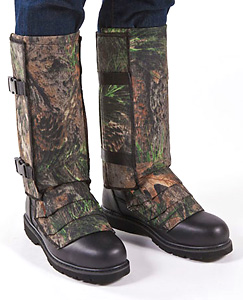Depending on where you live, spring is in the air either a little or a lot, or maybe not at al l yet. If you're in a southern or western state, you're probably getting out and about more— in the woods or the desert— to prospect, metal detect, and just clean up the backyard and flower beds (don't forget your Woodman's Pal machete for clearing brush and pruning). As you venture outside more often, or travel to sunnier climates, keep in mind that it is not too early in the season to have to worry about snake bite protection. A warmer than expected winter in some places has caused snakes to come out of hibernation earlier than usual. Just recently, a 14-year-old boy was airlifted out of Mission Trails Regional Park in San Diego, California after a rattlesnake bit his leg. In Arizona, an adult was badly bitten on the knuckle of his middle finger. In warmer southern states, snakes often don't go into hibernation at all. Instead, they go into "brumation."
l yet. If you're in a southern or western state, you're probably getting out and about more— in the woods or the desert— to prospect, metal detect, and just clean up the backyard and flower beds (don't forget your Woodman's Pal machete for clearing brush and pruning). As you venture outside more often, or travel to sunnier climates, keep in mind that it is not too early in the season to have to worry about snake bite protection. A warmer than expected winter in some places has caused snakes to come out of hibernation earlier than usual. Just recently, a 14-year-old boy was airlifted out of Mission Trails Regional Park in San Diego, California after a rattlesnake bit his leg. In Arizona, an adult was badly bitten on the knuckle of his middle finger. In warmer southern states, snakes often don't go into hibernation at all. Instead, they go into "brumation."
Hibernation is a deep sleep, usually occuring in colder, snow covered climates in northern states. Snakes don't actually sleep in brumation, but their bodies acclimate to a lower temperature, their metabolism slows, and they become less active and less inclined to feed. Brumation or hibernation is necessary for breeding. If male snakes don't cool down at some point during the year, they most likely would not be able to produce fertile sperm.
 On warm days, brumating snakes sometimes come out of their dens to bask in the sunshine. Nice sunny winter days are often when people are
On warm days, brumating snakes sometimes come out of their dens to bask in the sunshine. Nice sunny winter days are often when people are  surprised by snakes. Just like us, snakes head out to enjoy the sun and unsuspecting humans can startle them and cause them to strike. Rattlesnakes usually try to get way from people and bite only when attacked -- or when they perceive they are being threatened or attacked. Many bites occur when snakes are accidentally stepped on. Wear snake gaiters or snake boots and you'll know you're protected in case that happens. Gaiters are also great protection against thorns, pricker bushes, and cacti needles. If you've ever brushed against cacti while on a hike, you know how painful they can be and how hard to remove those needles are!
surprised by snakes. Just like us, snakes head out to enjoy the sun and unsuspecting humans can startle them and cause them to strike. Rattlesnakes usually try to get way from people and bite only when attacked -- or when they perceive they are being threatened or attacked. Many bites occur when snakes are accidentally stepped on. Wear snake gaiters or snake boots and you'll know you're protected in case that happens. Gaiters are also great protection against thorns, pricker bushes, and cacti needles. If you've ever brushed against cacti while on a hike, you know how painful they can be and how hard to remove those needles are!
Generally, rattlesnakes emerge from true hibernation in March or April, or when the average daytime temperatures reach and remain about 60 degrees Fahrenheit and higher. In the spring, keep in mind that emerging snakes are hungry, thirsty, and ready for love! With spring approaching, follow the Boy Scout motto and be prepared. Just like the US Border Patrol, US Forestry Service, hunters, hikers, fishermen, ranchers, surveyors, realtors, landscapers, and thousands of treasure hunters, wear snake gaiters or snake boots and you'll know you're protected when in the desert or woods. Don't take a chance!







